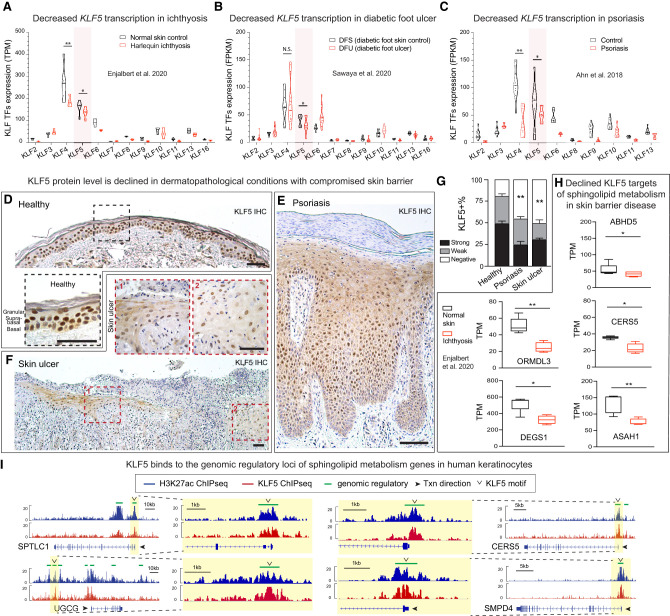Figure 7.
KLF5 is suppressed in human skin diseases manifesting secretory defects. (A–C) Publicly available data sets were analyzed to show the expression of Krüppel-like factor 5 (KLF5) and other KLF family members: bulk RNA-seq for normal skin and Harlequin ichthyosis patient samples (A), diabetic foot skin control and diabetic foot ulcer (B), and normal skin and psoriasis samples (C). Unpaired t-test was performed. (*) P < 0.05, (**) P < 0.01, (N.S.) not significant. (TPM) Transcripts per million, (FPKM) fragments per kilobase million. (D–F) IHC of KLF5 in human biopsies demonstrates that KLF5 is highly enriched in human normal skin epidermis (D) and is suppressed in psoriasis (E) and skin ulcer (F). Dashed line frames show the corresponding magnified regions. Scale bars, 50 μm. (G) Quantifications of KLF5 expression (strong, weak, or negative) based on immunohistochemistry (IHC) signals from D–F. Healthy: n = 3; psoriasis: n = 6; ulcer: n = 1. One-way ANOVA with multiple comparisons was performed. Data are mean ± SEM. (**) P < 0.01. (H) A publicly available GEO data set (GSE131903) was used to plot RNA-seq TPM data showing decreased expression in ichthyosis sample compared with normal skin. Unpaired t-test was used. (*) P < 0.05, (**) P < 0.01. (I) H3K27ac ChIP-seq (blue) and KLF5 ChIP-seq (red) tracks showing KLF5-associated putative regulatory elements (denoted as green lines above the tracks) of selected sphingolipid metabolism genes in cultured human keratinocytes. Open arrowheads denote KLF5 motifs under KLF5 peaks.

